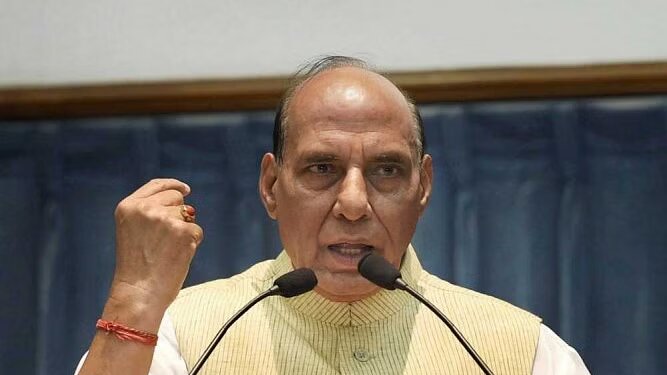Defense Minister Rajnath Singh spoke to the top naval commanders on India’s first homegrown aircraft carrier, INS Vikrant, in the Arabian Sea on Monday and watched a huge wargame. This was done in response to China’s growing military presence in the Indian Ocean region.
As the 43,000-ton steel behemoth and a fleet of over 20 frontline frigates, destroyers, and submarines sailed across the high seas, Singh, who was sitting in the Main Briefing Room of the 262-meter-long, 59-meter-tall ship, said that it was very important to keep a “constant vigil” on the northern, western, and coastal borders.
In his speech at the first session of the naval commanders’ conference, the defence minister praised the force for “standing firm” and protecting national interests with courage and dedication. He also said that future conflicts will be unpredictable and that the armed forces must be ready to deal with new challenges.
Before speaking to the naval commanders at the twice-yearly naval conference, Singh, Chief of Defence Staff Gen. Anil Chauhan, Navy Chief Admiral R. Hari Kumar, and other naval commanders watched a mega wargame with Vikrant, the ships that were with it, and almost all attack aircraft, including MiG-29K deck-based jets.
Admiral Kumar told reporters, “This is a moment in history.”
Rajnath Singh said that the country’s economy will change because of the defence industry. He told the commanders to keep working on developing capabilities for the future so they could deal with the new security problems in the maritime domain.
“Orders worth more than USD 100 billion are expected to be placed in the defence sector in the next 5–10 years, and it will become a major contributor to the country’s economic growth,” he said.
“Our defence industry is on the runway right now, and when it takes off, it will change the economy of the country,” he said.
The Chief of Naval Staff said that at the commanders’ conference, all policy decisions, questions about acquisition, and force planning are being talked about.
“The purpose of the conference is to look at what the problems are, where we are, what the gaps are, and how we can move forward,” he said.
During the exercises on Monday, warships from both the Eastern and Western fleets were used.
Officials said that the wargame was the end of the three-month-long Tropex exercise, which was called the Navy’s biggest drill of its kind. It began in December to test the force’s overall operational capability in light of the changing security matrix in the region.
Two prototypes of the naval version of the locally made Light Combat Aircraft also showed how quickly they could land on the deck of the huge aircraft carrier that Prime Minister Narendra Modi gave to the Navy in September.
The decision to hold the first part of the commanders’ conference onboard the INS Vikrant is “pretty significant,” a top military official said, implying that it is a show of power in response to China’s assertiveness.
Built at a cost of about Rs 23,000 crore, INS Vikrant can hold 30 fighter jets and helicopters and has a sophisticated air defence network and anti-ship missile systems.
At the ship’s launching ceremony, Prime Minister Modi called it a “floating city” and said it shows that India is getting better at defending itself.
An official said that the flight deck of the carrier is about the size of almost two football fields.
The official said that, given the current geostrategic situation in the region, the conference has its own importance and relevance.
Goa will be the site of the second day of the conference. A few days after that, the last part of the conference will take place in Delhi.
In his speech, Singh also talked about how the Navy is a reliable and responsive presence in the Indian Ocean area.
He said that Mission-Based Deployments of the Navy have made India a “preferred security partner” of friendly foreign countries in the region.
The defence minister said again that a big country like India needs to be able to protect itself without help from other countries.
Singh also praised the Navy for being at the forefront of making things in India and coming up with new ideas by bringing in ships and submarines and making niche technologies.
He said that the launch of the INS Vikrant made him even more sure that India’s naval design and development are at a good point and that more progress will be made in the future.
The defence minister saw complex operations with the aircraft carrier and fleet, ships and planes firing weapons, and ships and planes getting supplies while at sea.
The defence minister also saw a demonstration of homegrown products, such as a spotter drone, a remote-controlled lifebuoy, and a fire-fighting system.
Also shown were the steps the Indian Navy has taken to “pole vault” ahead of the technology curve by using their own resources in big data analytics, artificial intelligence, laser technology, and cryptography.
The conference gives naval commanders a place to talk about important security issues at the military-strategic level and to talk with high-level government officials in a structured way.
Chief of Defence Staff Gen. Anil Chauhan, Army Chief Gen. Manoj Pande, and Air Chief Marshal VR Chaudhari will also talk to the naval commanders about how the three services can work together in a common operational environment.
During the conference, naval commanders would also get an update on how the Agnipath scheme was being put into place.
Under the plan, the first group of “Naval Agnives,” which will include women, will leave INS Chilka at the end of March.
The Navy said that the commanders’ conference would be important and will focus on the problems India is facing in the maritime domain.
“The Indian Navy remains focused on being a combat-ready, credible, cohesive, and future-proof force,” the Navy said in a statement on Sunday. “It continues to work hard to carry out its role as the country’s maritime security guardian.”
